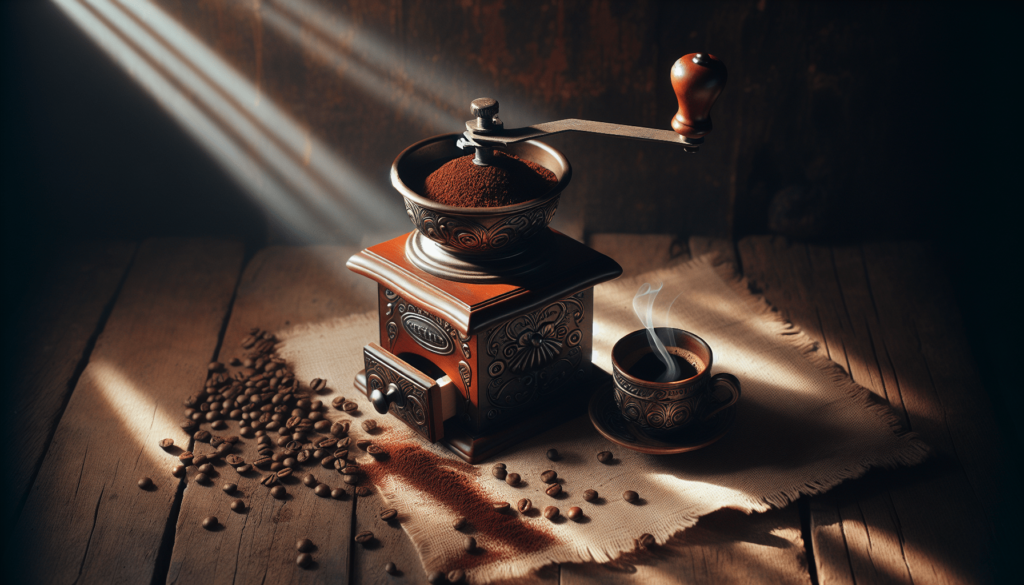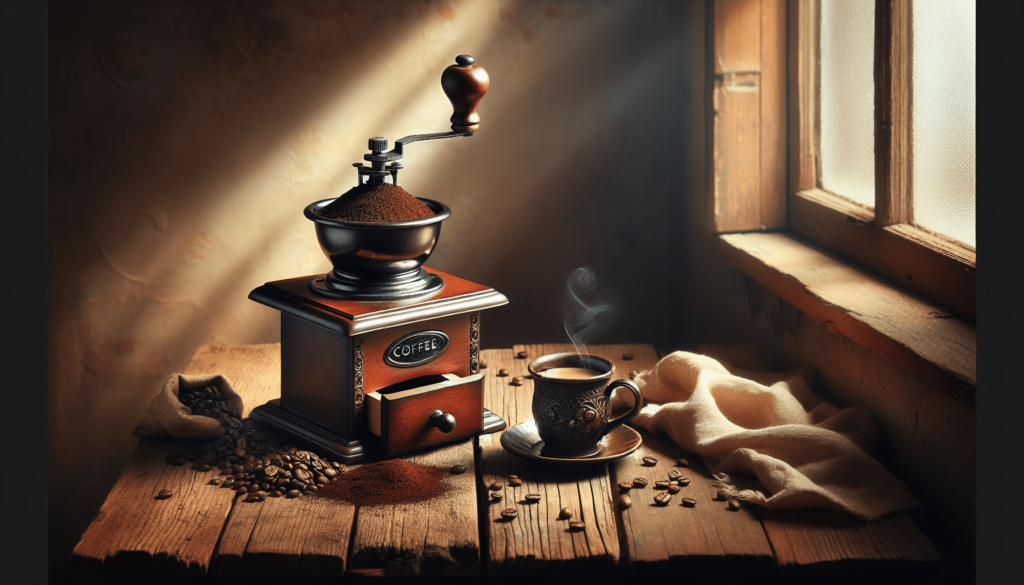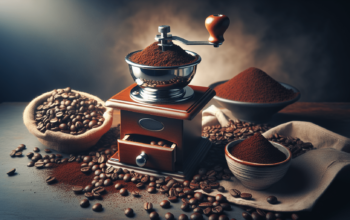What’s your favorite way to enjoy a cup of coffee? Brewing your own coffee can be a delightful ritual, and there’s a world of flavors awaiting you within those humble ground coffee beans.
Understanding Ground Coffee Beans
When we talk about ground coffee beans, we’re referring to coffee that has been processed from roasted coffee beans. Imagine the rich aroma that wafts through your kitchen as you prepare to brew your morning cup. The process of grinding coffee transforms it into a form that can be brewed and enjoyed.
The Journey of Coffee from Bean to Brew
Every coffee cup starts its journey as a seed inside a coffee cherry. After being picked, the beans are processed, roasted, and eventually ground. This stage is crucial because the grind size directly influences the flavor and strength of your coffee.
Types of Ground Coffee
There are various grind sizes, and understanding each can greatly enhance your brewing experience. Here’s a handy breakdown:
| Grind Size | Description | Best Brewing Methods |
|---|---|---|
| Coarse | Chunky, similar to sea salt | French Press, Cold Brew |
| Medium Coarse | Gritty, like sand | Chemex, Pour Over |
| Medium | Granular, like table salt | Drip Coffee, AeroPress |
| Medium Fine | Slightly finer than sand | Espresso, Moka Pot |
| Fine | Powdery, like flour | Turkish Coffee |
| Extra Fine | Very fine, resembling powdered sugar | Specialty Coffee Methods |
Each method brings out unique flavors, so experimenting with grind sizes is worth your time.
Choosing Your Coffee Beans
The type of coffee bean you choose directly impacts the flavor profile of your brewed coffee. Here are some common types you might consider:
- Arabica: Known for its smooth, complex flavors and aromatic qualities.
- Robusta: Generally stronger and more bitter, often used in espresso blends.
- Liberica: Offers a unique flavor with floral and fruity notes.
- Excelsa: Often described as fruity and tart, it adds depth to blends.
Whichever bean you choose, the quality and freshness will enhance your brewing experience.
The Importance of Freshness
Freshly ground coffee is vital for achieving the best possible flavor. Coffee beans start to lose their freshness almost immediately after grinding. Opt for whole beans and grind them just before brewing. Store your beans in an airtight container in a cool dark place to maintain their freshness for longer.
Brewing Techniques to Try
With your ground coffee beans selected, it’s time to discuss brewing techniques. Each method offers a different way to extract those delightful flavors. Let’s look at some popular brewing methods.
French Press
The French Press method is a classic favorite among coffee lovers. It’s simple, effective, and allows for maximum flavor extraction.
-
What You’ll Need:
- Coarse ground coffee
- French Press
- Hot water
-
How to Brew:
- Add about 1 ounce (28 grams) of coffee to your French Press.
- Pour in hot water, about 15 ounces (450 ml), and stir.
- Place the lid on the French Press and steep for about 4 minutes.
- Slowly press down the plunger and pour yourself a cup.
This method results in a rich, full-bodied coffee that many people adore.
Pour Over
For those who enjoy a clean cup of coffee, the pour-over method is a fantastic choice. It allows for precise control over the brewing process.
-
What You’ll Need:
- Medium ground coffee
- Pour-over dripper
- Paper filter
- Hot water
-
How to Brew:
- Place a paper filter in the dripper and rinse it with hot water.
- Add 1-2 tablespoons of coffee per 6 ounces of water.
- Pour a small amount of water over the coffee to let it bloom for about 30 seconds.
- Slowly pour more hot water in a circular motion until you reach the desired amount of brewed coffee.
The pour-over method reveals the coffee’s unique flavors and aromas, making each cup an experience.
Espresso
If you enjoy a strong, concentrated coffee, consider brewing espresso. This method requires a specific grind size and equipment but can be immensely rewarding.
-
What You’ll Need:
- Fine ground coffee
- Espresso machine
- Hot water
-
How to Brew:
- Place about 18-20 grams of finely ground coffee into the portafilter.
- Tamp the coffee down evenly.
- Lock the portafilter into the machine and start brewing.
- Brew for about 25-30 seconds to extract a delicious shot of espresso.
Espresso can be enjoyed on its own or used as a base in various coffee beverages like lattes and cappuccinos.
Cold Brew
Cold brew coffee has surged in popularity for its smooth, low-acidity profile. It’s especially refreshing during hot weather.
-
What You’ll Need:
- Coarse ground coffee
- Large jar or pitcher
- Cold water
-
How to Brew:
- Combine 1 cup of coarsely ground coffee with 4 cups of cold water.
- Stir to ensure all grounds are moistened.
- Let it steep in the fridge for 12-24 hours.
- Strain the coffee with a fine mesh strainer or cheesecloth.
Cold brew can be served over ice, diluted with water or milk, and sweetened to your preference.
AeroPress
The AeroPress has gained a loyal following due to its versatility and ease of use. This method allows for experimentation with brew times and flavors.
-
What You’ll Need:
- Medium-fine ground coffee
- AeroPress
- Hot water
-
How to Brew:
- Add 14-18 grams of coffee to the AeroPress.
- Pour hot water over the coffee and stir briefly.
- Secure the filter cap and slowly press down for about 20-30 seconds.
- Enjoy the espresso-style coffee produced by this method.
Siphon
Siphon brewing is a visually stunning method that involves a little more equipment and technique but can produce a beautiful and aromatic coffee.
-
What You’ll Need:
- Medium ground coffee
- Siphon coffee maker
- Heat source
-
How to Brew:
- Fill the bottom chamber with water and add coffee grounds to the top chamber.
- Heat the water until it boils, causing it to rise into the top chamber.
- Once all the water is in the top chamber, stir.
- Remove heat; as the coffee brews, it will flow back down.
The process is mesmerizing, and the resulting coffee is often rich and aromatic.

Making Adjustments
No matter which brewing method you choose, remember that small adjustments can have a big impact on your coffee.
Water Temperature
The ideal water temperature for brewing coffee typically ranges between 195°F to 205°F (90°C to 96°C). Using water that’s too hot can lead to over-extraction, resulting in bitterness, while water that’s too cold may yield under-extraction, producing a weak flavor.
Coffee-to-Water Ratio
Finding the right coffee-to-water ratio is essential for achieving the perfect brew. A common starting point is 1:15 or 1:16 (coffee to water by weight). This can be adjusted based on personal preference. If you prefer stronger coffee, try increasing the amount of coffee slightly.
Brew Time
The time you allow your coffee to steep or brew will affect its flavor. For instance, a French Press typically requires about 4 minutes, while cold brew needs a 12-24 hour steeping time. Experimenting with these times can help you fine-tune your perfect cup.
Enhancing Your Coffee Experience
Learning the art of brewing is only the beginning. There are numerous ways to enhance your coffee experience.
Flavoring Your Coffee
Many people enjoy adding flavors or sweeteners to their coffee. Here are some options to consider:
- Cream and Milk: A splash of cream or milk can mellow the coffee’s potency and add a silky texture.
- Sugar or Sweeteners: Experiment with different types of sugar or sweeteners to find your preferred level of sweetness.
- Spices and Extracts: Adding a sprinkle of cinnamon or a drop of vanilla extract can introduce a whole new layer of flavor.
Pairing with Food
Pairing coffee with food can elevate your tasting experience. Enjoy your coffee alongside pastries, chocolate, or breakfast items. The right pairing can enhance the flavors and make for an unforgettable meal.
Experimenting with Blends
Don’t shy away from blending different coffee beans! Mixing beans can create unique flavor profiles. Try combining a fruity Arabica with a bold Robusta for an intriguing balance.

Storing Your Ground Coffee
Long-term storage of coffee, whether whole beans or ground, is crucial for maintaining freshness and flavor. Here’s how to do it right.
Containers
Store your coffee in an airtight container. Vacuum-sealed containers help keep oxygen, moisture, and light at bay, preserving that delightful aroma and taste.
Temperature
Keep your coffee in a cool, dark place, away from heat sources. A pantry or cupboard away from direct sunlight is usually ideal. Avoid the refrigerator, as coffee can absorb odors from other foods.
Duration
Remember that ground coffee loses its freshness much quicker than whole beans. Aim to use your ground coffee within 1-2 weeks for the best flavor.
Conclusion
Brewing coffee with ground beans is both an art and a science. By understanding the fundamentals—such as bean selection, grind size, brewing techniques, and storage—you can elevate your coffee experience to new heights. Take the time to experiment with different methods, flavors, and pairings to find what resonates with your palate. Each cup you brew can be a little journey of flavors, aromas, and personal preferences—enjoy the adventure!

